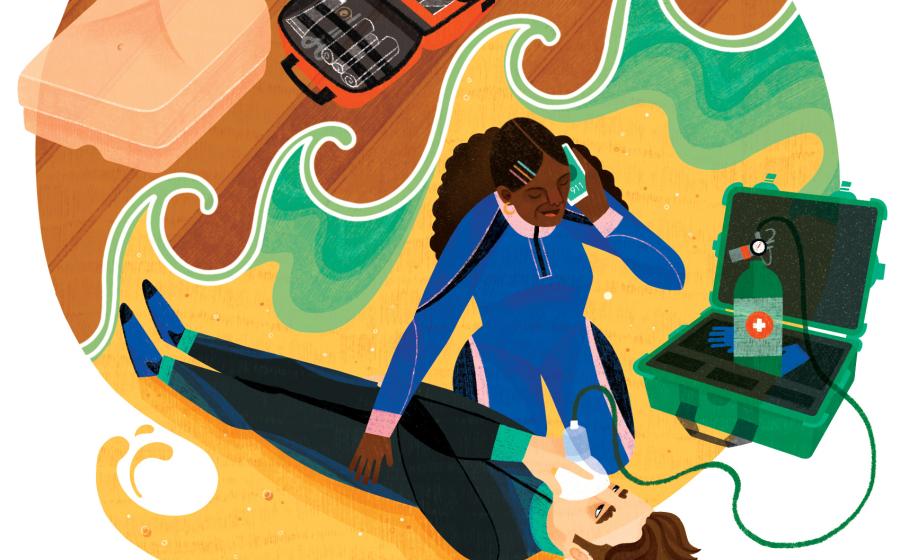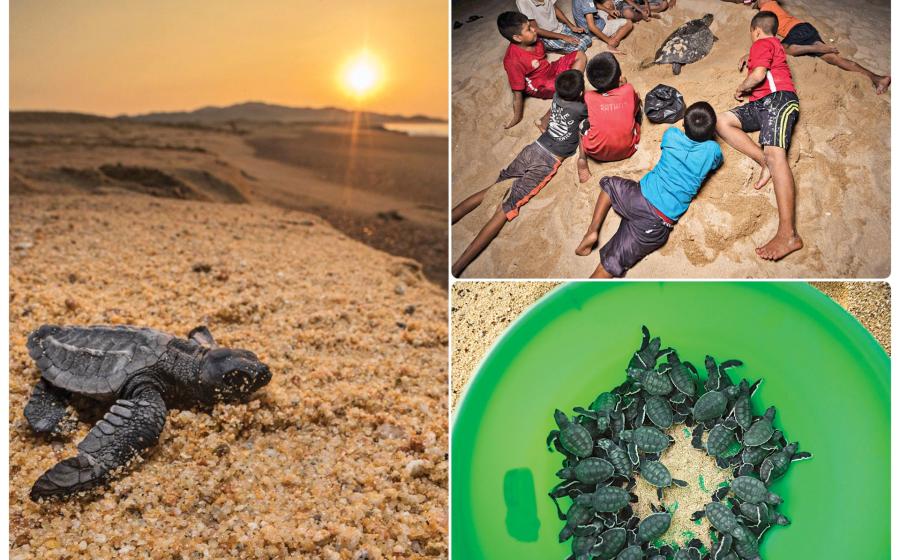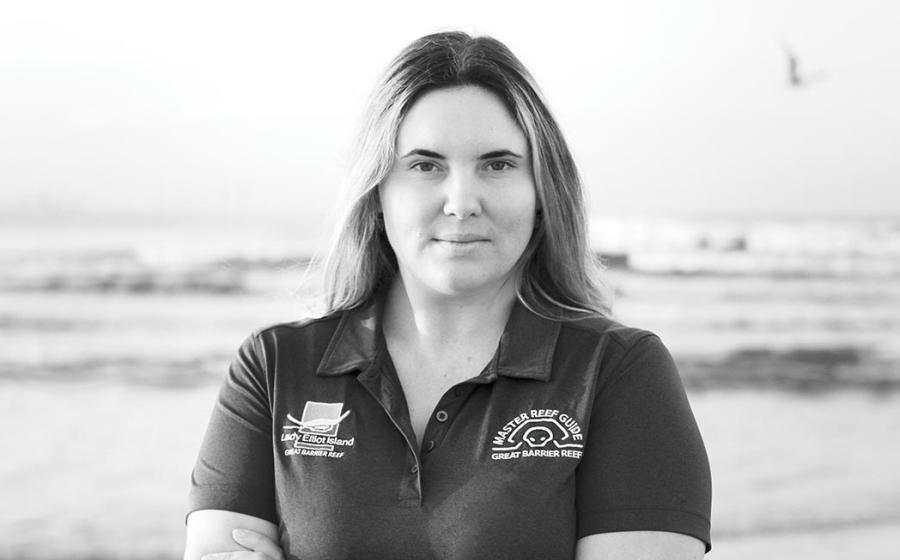Liveaboard: Humpback Whales of the Dominican Republic
My Little Valentine
There are few guarantees in life, fewer still when it involves marine life. Shark feeds are one, but when it comes to natural encounters, nothing’s a sure thing. Except for the humpback whales of the Dominican Republic’s Silver Bank.
“I guarantee you will see humpbacks,” says Rob Smith, second captain of Turks & Caicos Aggressor II, as we settle in for the crossing to Silver Bank, nine hours north of Puerto Plata.
Boats have been coming here for 27 years, and they’ve got the whale watching down to a science. “North Atlantic humpbacks arrive here on Silver Bank to calve, mate and frolic,” says Capt. Amanda Smith. Whales start arriving in late November, departing for the North Atlantic to feed in late April; boats offer a brief 10-week schedule to coincide with the busiest period.
As certain as beach traffic in summer, the humpbacks are here. Within minutes, we are treated to half a dozen breaches and tail slaps, a few tail lobs, and a fluke display.
Hot and Heavy
We enjoy some brief mother-and-calf engagements our first afternoon, but we’re skunked the second day. On the morning of our third day we see a handful of whales, but they are all going somewhere other than where we are.
An hour into the afternoon session, our spirits are lagging. The mother-and-calf pairs have disappeared, and the possibility of another day without an in-water encounter looms when a pair of whales pops up beneath the tender. They forge ahead, circle back and swim under the tender. Smith tells us to get our fins on; we’ve stumbled upon a “Valentine.”
It is a marvelous courtship: The female is in a fugue like state — slow moving and with a glaze in her eyes. The male swims beneath her with open pectorals before surfacing to slap the water with his pectoral fins, or fluke.
An hour in, two new males appear. Smith calls us out of the water; we watch as the original suitor battles his rivals using an array of bubble screens, peck slaps and tail lobs. Just 20 minutes in, and the interlopers are defeated. Our Valentine couple re-emerges, inviting us once again to watch their amorous dalliance.
I wouldn’t have believed it if I didn’t see it with my own eyes, but as our tender** **is pulling away, the two whales surface, arch their backs, and sink one last time, their flukes synchronizing perfectly in a final farewell. I’m reminded of the date — Feb. 12 — when my roommate, John Curtis, says, “Valentine’s Day came early.”
Mother-and-Child Reunion

There are two spots in the world you can safely and reliably — not to mention legally — enter the water with humpbacks: Tonga and the Dominican Republic. Tonga is difficult and expensive to get to; the Dominican Republic is neither. Only four boats hold a permit for in-water experiences on Silver Bank: two of which are Sun Dancer II and Turks & Caicos Aggressor II.
Even if you’re a longtime Aggressor devotee, this liveaboard trip is unlike any other. For starters, there isn’t the excitement of the unknown: We know what we’re going to see every day.
Second, don’t discount the different feeling you get from taking on no nitrogen. “It took me the longest time to finally get down here because I was a snorkel snob,” says photographer Scott Johnson, who’s done this trip three times. I know what he means. There’s a different ebb and flow to getting geared up in just a mask, snorkel and fins.
The final difference is more subtle. “On most dive trips, we’re there to see various animals,” says Johnson. “On this trip, we’re here to see behavior."
Scientists believe the humpbacks prefer Silver Bank because it’s warm and there are no fish — which equals no predators. That’s conducive to mating behavior, especially heat runs (aka rowdies), in which a female is pursued by more than one male. Silver Bank is also good for mothers that give birth to calves, either on the way to the Dominican Republic or shortly after arriving.
The next morning we see how comfortable the whales have become on Silver Bank. After an hour with an unruly Valentine couple, as we head back in for lunch, one of the Sun Dancer II tenders calls to us on radio. (The boats here are extremely collaborative, sharing whale experiences.) They’ve found an exceedingly receptive mother and calf, but are headed in to lunch and want to know whether we’d “babysit” for them. Ten minutes later, we are in the water with a mother and her 8-foot-long calf.
“Some of the best encounters are when the mom’s sleeping,” says Johnson. “The calf has to come up for air every two to four minutes, four times for every breath the mom takes.” Which is exactly what plays out. The mother hovers 30 feet deep, while the calf alternates nuzzling her nose, cuddling up beneath a peck, or playing hide-and-seek with us. Harangued by pilot fish picking at the new skin that is sloughing of, the calf pops to the surface and parades past us before returning to its mother.
Be My Valentine
The final day is a “best-of” whale display. The morning starts with a pack of rowdies, which tail-slap and breach their way toward us.
Next we encounter a couple of sleepers which, as the name suggests, aren’t too exciting. They mostly sleep, rousing every 20 minutes before descending to 30 feet and nodding of again. We are hoping they’ll wake and start a Valentine, but after four breath cycles, we move on.
Good thing we did, because TCII’s other tender has found the same mother- and-calf pair from the previous day. We get about four of mom’s breath cycles, enjoying the calf as it swims in front of the line of snorkelers.
We power through lunch because, as Smith says, “It’s whale soup out here.” At one point we are tracking two mother- and-calf pairs, along with a group of rowdies that keep popping their flukes into the air.
Finally we settle on a mother and calf with a lone male escort. As soon as we approach, the three swim straight at the boat, and for an hour and a half lead us on a circuitous tour of the narrow coral-reef passages around the Polyxeni wreck, near TCII’s mooring.
Shots of a whale’s fluke are awesome, and the male escort is showing of. But the shots are also “naked,” with no back- ground or foreground in the wide ocean. As we follow the trio, we notice we are getting close to the wreck. The ultimate fluke shot is lining up, but every time the male raises his fluke, it’s at a poor angle or barely out of the water. Time is running out — the water near the wreck is get- ting progressively shallower and more hazardous, with numerous patch reefs.
Then it happens. About 100 yards of the wreck the male stops, raises his fluke 8 feet out of the water, and waves it side to side. Our tender erupts in cheers.
We follow the whales for another 500 yards, but the sun is going down, and it’s too treacherous to follow them without being able to see the reefs. As we head home, I look back to see the whales in a tangle of white water and bodies.
It’s a proper send-of for an amazing trip, one where I don’t log a single second of nitrogen time. On the return trip, I watch my videos of Valentines, mothers and calves, and the sleepers. And next Valentine’s Day, I may watch them again, to get me in the mood for a little love.


Scott JohnsonA humpback mother swims upside down with her calf.
My Little Valentine
There are few guarantees in life, fewer still when it involves marine life. Shark feeds are one, but when it comes to natural encounters, nothing’s a sure thing. Except for the humpback whales of the Dominican Republic’s Silver Bank.
“I guarantee you will see humpbacks,” says Rob Smith, second captain of Turks & Caicos Aggressor II, as we settle in for the crossing to Silver Bank, nine hours north of Puerto Plata.
Boats have been coming here for 27 years, and they’ve got the whale watching down to a science. “North Atlantic humpbacks arrive here on Silver Bank to calve, mate and frolic,” says Capt. Amanda Smith. Whales start arriving in late November, departing for the North Atlantic to feed in late April; boats offer a brief 10-week schedule to coincide with the busiest period.
As certain as beach traffic in summer, the humpbacks are here. Within minutes, we are treated to half a dozen breaches and tail slaps, a few tail lobs, and a fluke display.

Scott JohnsonGuests are treated to a showy display by a breaching humpback.
Hot and Heavy
We enjoy some brief mother-and-calf engagements our first afternoon, but we’re skunked the second day. On the morning of our third day we see a handful of whales, but they are all going somewhere other than where we are.
An hour into the afternoon session, our spirits are lagging. The mother-and-calf pairs have disappeared, and the possibility of another day without an in-water encounter looms when a pair of whales pops up beneath the tender. They forge ahead, circle back and swim under the tender. Smith tells us to get our fins on; we’ve stumbled upon a “Valentine.”

Scott JohnsonBreaching is often seen in rough seas — it is possible that a breach allows the whale to breathe easier when the seas are rough.
It is a marvelous courtship: The female is in a fugue-like state — slow moving and with a glaze in her eyes. The male swims beneath her with open pectorals before surfacing to slap the water with his pectoral fins, or fluke.
An hour in, two new males appear. Smith calls us out of the water; we watch as the original suitor battles his rivals using an array of bubble screens, pec slaps and tail lobs. Just 20 minutes in, and the interlopers are defeated. Our Valentine couple re-emerges, inviting us once again to watch their amorous dalliance.

Scott JohnsonIt's also possible that the whales use breaching to communicate when the noise of the ocean might be masking acoustic signals.

Scott JohnsonA young humpback puts on a display near the Polyxeni.
I wouldn’t have believed it if I didn’t see it with my own eyes, but as our tender** **is pulling away, the two whales surface, arch their backs, and sink one last time, their flukes synchronizing perfectly in a final farewell. I’m reminded of the date — Feb. 12 — when my roommate, John Curtis, says, “Valentine’s Day came early.”

Scuba Diving EditorsWhy Choose the Turks and Caicos Aggressor II?
Mother-and-Child Reunion
There are two spots in the world you can safely and reliably — not to mention legally — enter the water with humpbacks: Tonga and the Dominican Republic. Tonga is difficult and expensive to get to; the Dominican Republic is neither. Only a handful of boats hold a permit for in-water experiences on Silver Bank: one of which is the Turks and Caicos Aggressor II.
Even if you’re a longtime Aggressor devotee, this liveaboard trip is unlike any other. For starters, there isn’t the excitement of the unknown: We know what we’re going to see every day.
Second, don’t discount the different feeling you get from taking on no nitrogen. “It took me the longest time to finally get down here because I was a snorkel snob,” says photographer Scott Johnson, who’s done this trip three times. I know what he means. There’s a different ebb and flow to getting geared up in just a mask, snorkel and fins.
The final difference is more subtle. “On most dive trips, we’re there to see various animals,” says Johnson. “On this trip, we’re here to see behavior."
Scientists believe the humpbacks prefer Silver Bank because it’s warm and there are no fish — which equals no predators. That’s conducive to mating behavior, especially heat runs (aka rowdies), in which a female is pursued by more than one male. Silver Bank is also good for mothers that give birth to calves, either on the way to the Dominican Republic or shortly after arriving.
The next morning we see how comfortable the whales have become on Silver Bank. After an hour with an unruly Valentine couple, as we head back in for lunch, one of the other liveaboard tenders calls to us on radio. (The boats here are extremely collaborative, sharing whale experiences.) They’ve found an exceedingly receptive mother and calf, but are headed in to lunch and want to know whether we’d “babysit” for them. Ten minutes later, we are in the water with a mother and her 8-foot-long calf.
“Some of the best encounters are when the mom’s sleeping,” says Johnson. “The calf has to come up for air every two to four minutes, four times for every breath the mom takes.” Which is exactly what plays out. The mother hovers 30 feet deep, while the calf alternates nuzzling her nose, cuddling up beneath a pec, or playing hide-and-seek with us. Harangued by pilot fish picking at the new skin that is sloughing off, the calf pops to the surface and parades past us before returning to its mother.
Be My Valentine
The final day is a “best-of” whale display. The morning starts with a pack of rowdies, which tail-slap and breach their way toward us.
Next we encounter a couple of sleepers which, as the name suggests, aren’t too exciting. They mostly sleep, rousing every 20 minutes before descending to 30 feet and nodding off again. We are hoping they’ll wake and start a Valentine, but after four breath cycles, we move on.
Good thing we did, because TCII’s other tender has found the same mother-and-calf pair from the previous day. We get about four of mom’s breath cycles, enjoying the calf as it swims in front of the line of snorkelers.
We power through lunch because, as Smith says, “It’s whale soup out here.” At one point we are tracking two mother-and-calf pairs, along with a group of rowdies that keep popping their flukes into the air.
Finally we settle on a mother and calf with a lone male escort. As soon as we approach, the three swim straight at the boat, and for an hour and a half lead us on a circuitous tour of the narrow coral-reef passages around the Polyxeni wreck, near TCII’s mooring.

Scuba Diving EditorsNeed to Know
Shots of a whale’s fluke are awesome, and the male escort is showing off. But the shots are also “naked,” with no background or foreground in the wide ocean. As we follow the trio, we notice we are getting close to the wreck. The ultimate fluke shot is lining up, but every time the male raises his fluke, it’s at a poor angle or barely out of the water. Time is running out — the water near the wreck is getting progressively shallower and more hazardous, with numerous patch reefs.
Then it happens. About 100 yards of the wreck the male stops, raises his fluke 8 feet out of the water, and waves it side to side. Our tender erupts in cheers.
We follow the whales for another 500 yards, but the sun is going down, and it’s too treacherous to follow them without being able to see the reefs. As we head home, I look back to see the whales in a tangle of white water and bodies.
It’s a proper send-off for an amazing trip, one where I don’t log a single second of nitrogen time. On the return trip, I watch my videos of Valentines, mothers and calves, and the sleepers. And next Valentine’s Day, I may watch them again, to get me in the mood for a little love.










